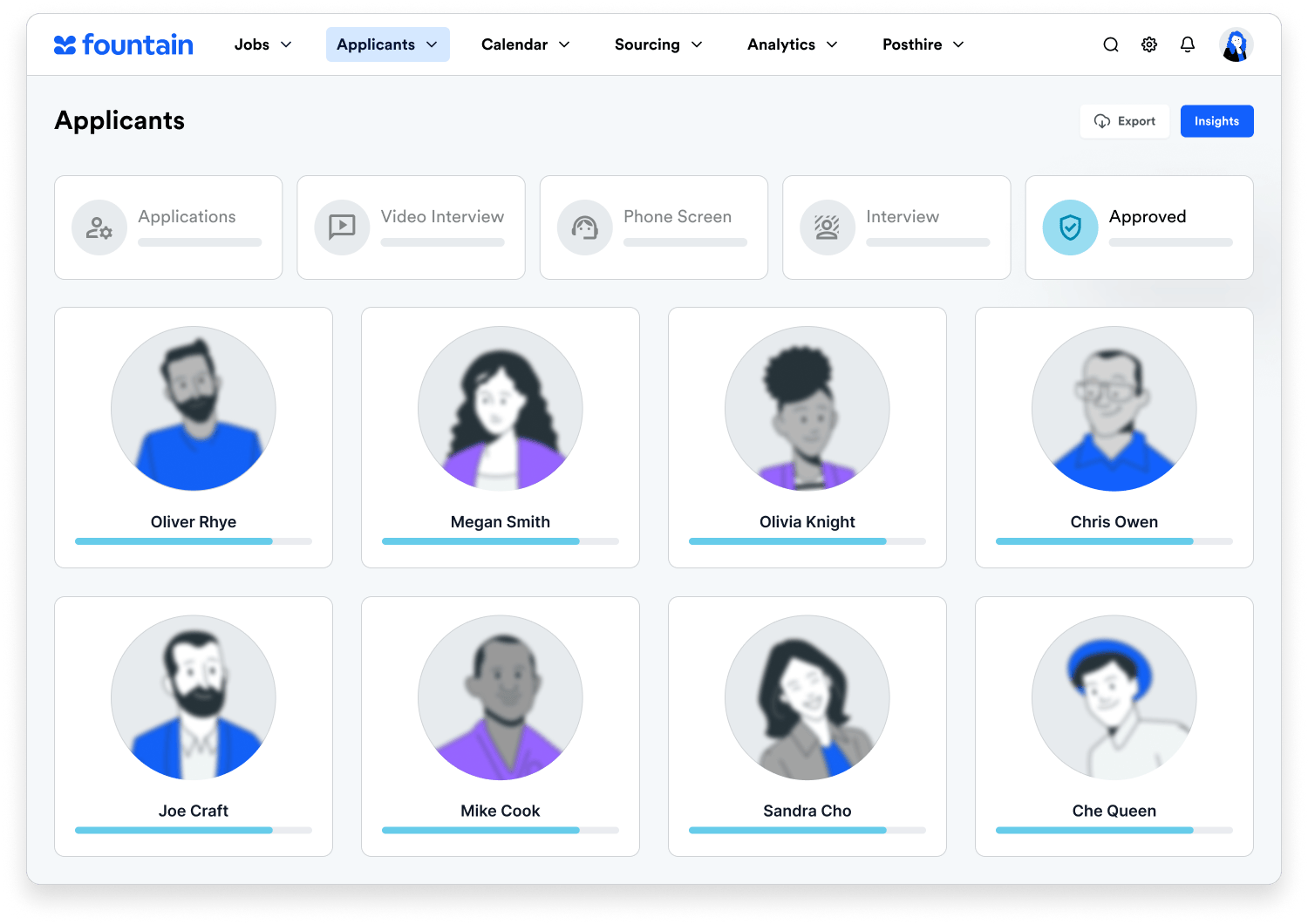Nothing is more uncertain than the future, but we have good news: 2024’s high volume hiring trends point to a successful year of hiring,
How do we know? We’ve scoured, searched, and surveyed recruiters, and we’ve uncovered the top five high volume hiring trends of 2024. These trends build upon what we’ve learned in 2023, what we see our customers working toward, and how we envision new developments in hourly hiring translating to the greater labor market.
Keep reading to learn how these hiring trends emerged and how to apply them to your 2024 hiring strategy.
Hiring trend #1: AI will expand across the entire HR tech stack
AI has shown it can handle select tasks within the hiring process (e.g., interview scheduling, answering FAQs, etc.), but in 2024, its capabilities will expand across the entire hiring funnel, including post-hire processes.
Onboarding will be a crucial addition to ATS providers’ suite of services, transforming their hiring system into a completely end-to-end hiring solution for their customers.
Once candidates are hired, automation and AI will keep them moving into post-hire processes, which may look like sending digital paperwork through e-signature software, launching virtual training sessions, and employing interactive chatbots that answer common new-hire questions.
As a result of this extra automation, recruiters can devote their time to more detailed new-hire requests, all to help workers get up and running as quickly and efficiently as possible.
Hiring trend #2: Data and analytics will be non-negotiable
One strong argument for the ATS as a hiring tool is its ability to collect and analyze data and provide insights into the hiring process. This visibility into where candidates may be getting stuck, where they drop out, and how long it takes them to get through every stage will continue to be an invaluable asset for hiring teams as they vie for top talent from a small applicant pool.

As the competition for workers continues to rev up, recruiters will need these insights to win the race for quality talent and keep operations afloat.
Hiring trend #3: Interviews will go async
Video interviews are nothing new to the modern recruiter—this “video resume” style of applying for jobs became popular during the COVID-19 pandemic when in-person interviews weren’t feasible. But in 2024, we anticipate a precipitous rise in the use of asynchronous video interviews, which have a plethora of benefits for both recruiters and candidates.
According to a report by VideoAsk and Typeform, 69% of HR managers are planning to use asynchronous video interview software as part of their strategy to add more automation to the hiring process.
Async video interviews help remove the hassle of scheduling (and rescheduling) in-person or live video interviews, and also allow candidates to showcase their personality in a way that can’t be conveyed through their resume or basic application information.
Per our 2023 Annual Benchmarking Report, the use of video interviews has a direct effect on applicant engagement: Companies in the food services and restaurants sector that used video interviews saw a 60% completion rate by applicants compared to 45% for in-person or phone interviews.
Learn how to streamline your interview process for faster hiring and richer candidate experiences
Hiring trend #4: Employer branding will make or break the candidate experience
By the time job seekers apply for your openings, they’ve already done their due diligence about your company’s reputation.
Today’s applicants are more informed than ever. They’re well-versed in accessing a company’s information, social media channels, and general online presence to help them make decisions about nearly every choice they make. And applying for a job is no exception.
This presents a unique opportunity for HR and PR to sync about how an employer’s brand comes across in a typical job seeker’s search. Review sites, customer ratings, and an active Diversity, Equity, Inclusion, and Belonging (DEIB) program are just a few things a potential worker might consider for when deciding whether to apply for a job at a specific company.
When candidates enter a hiring process already feeling positive about the organization, this sentiment is likely to stay with them well into their employment and have a positive effect on worker productivity and longevity.

Hiring trend #5: Recruiting teams will tap into the ‘hidden workforce’
In the United States, there are 27 million people who make up the “hidden workforce.” These people may not have the education requirements or qualifications listed in most job descriptions, so they often fly under the radar for companies that use resume-scanning or keyword-searching technologies.
Hidden workers represent a variety of lifestyles and experiences, such as U.S. Veterans, formerly incarcerated individuals, people with developmental or neurodiversity challenges, caregivers, and anyone else who might not fall into the bucket of the “traditional” worker.
According to a report from Harvard Business School (HBS), hidden workers tend to outperform their peers in attitude and work ethic, productivity, work quality, attendance, and innovation. This might explain why companies that hire hidden workers report being 36% less likely to face talent and skills shortages compared to companies that don’t hire hidden workers.
To reach this population of workers, companies need to reassess their hiring practices to ensure they are equitable and simplified for people of all backgrounds and capabilities.
For example, HR teams can:
- generalize the list of qualifications for positions rather than making them narrow and exclusive,
- modify job descriptions to be more inclusive of varied backgrounds, and
- remove any language that might serve as a barrier to applicants whose experience doesn’t match exactly.
In the same report from HBS—which surveyed 8,000 hidden workers—workers felt that excessive job requirements disqualify them from consideration for positions they feel qualified for. When asked what employers could do to increase workers’ comfort with applying for jobs, hidden workers cited the following:
- Align the job title to the tasks (71%)
- Limit the skills requirements to the essentials (64%)
- Limit the use of jargon (62%)
- Limit academic requirements to the essentials (61%)
- Use inclusive and gender-neutral language (52%)
How Fountain customers are applying these trends
Here at Fountain, some of our customers that hire high volumes of workers already are employing these trends as part of their recruiting processes and seeing promising results.

Laundryheap devotes personal attention to onboarding
Laundryheap was able to emerge as the market leader in the on-demand laundry and dry cleaning space thanks to their ability to source and onboard partner drivers quickly.
“Fountain gives our recruitment team the bandwidth to invest in personalized one-on-one onboarding sessions with our partner drivers. This lets us set them up for success from day one.” —Mayur Bommai, Co-founder of Laundryheap
Marsden Services cuts unnecessary stages to save time and cut costs
Marsden Services noticed applicants to one of their client’s jobs were stuck in one of the drug-screening stages, waiting on results. This client wasn’t particular about the results of one of the drugs being tested, so the Marsden team stepped in and adjusted the workflow.
“Because of analytics, we modified our 10-panel screen to a five-panel by removing the particular drug screen, resulting in time savings and cost reduction.” —Roger Swartzendruber, VP of Human Resources, Marsden Services
Ready to embark on a year of hiring success? Download our 2024 Roadmap for High Volume HIring to read more about hiring trends and learn how to make this year your best yet.

